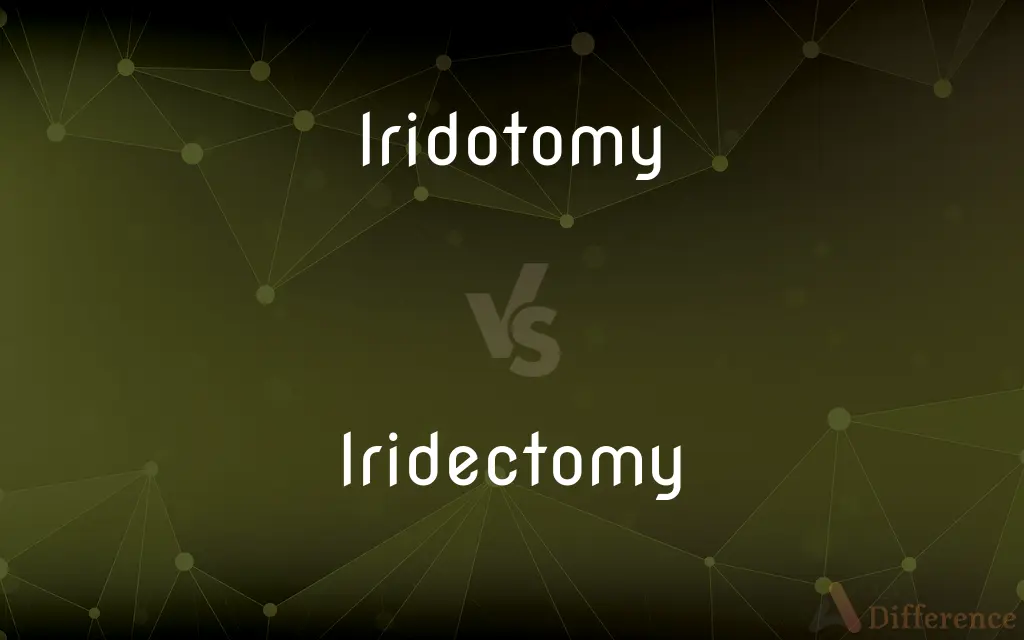Iridotomy vs. Iridectomy — What's the Difference?
By Urooj Arif & Fiza Rafique — Updated on April 18, 2024
Iridotomy involves making a small hole in the iris using a laser to relieve eye pressure, commonly used in narrow-angle glaucoma treatment; iridectomy involves removing a portion of the iris tissue, typically for severe or treatment-resistant cases.

Difference Between Iridotomy and Iridectomy
Table of Contents
ADVERTISEMENT
Key Differences
Iridotomy, specifically laser peripheral iridotomy (LPI), is a minimally invasive procedure used primarily to treat narrow-angle glaucoma. This procedure uses a laser to create a small hole in the iris, which helps fluid (aqueous humor) to flow better in the eye and reduces intraocular pressure. On the other hand, an iridectomy involves the surgical removal of a part of the iris and is used in cases where laser iridotomy may not be sufficient, or when the iris itself is causing obstruction or has suffered damage.
While iridotomy is generally performed as an outpatient procedure with minimal recovery time, iridectomy, being more invasive, may require more extensive post-operative care. Iridotomy is usually quick, involves less risk of infection, and patients often return to their normal activities within a day, whereas iridectomy might require stitches and a longer healing period.
In terms of indications, iridotomy is recommended for patients with narrow or closed angles in their eyes, which are at risk of developing acute angle-closure glaucoma. Whereas, iridectomy is often reserved for patients who cannot undergo laser procedures or in cases where the iris is physically blocking the drainage of aqueous humor, such as in iris bombe.
Iridotomy uses advanced laser equipment that allows precise control with minimal discomfort. Iridectomy, however, may involve either traditional surgical tools or lasers, depending on the specific circumstances and needs of the patient.
The choice between iridotomy and iridectomy depends on the severity of the condition, the specific anatomical issues of the patient’s eye, and how urgently the intraocular pressure needs to be reduced. Both procedures aim to prevent the progression of glaucoma by improving the outflow of aqueous humor.
ADVERTISEMENT
Comparison Chart
Procedure Type
Non-invasive, laser-based
Invasive, surgical removal
Primary Use
Treatment of narrow-angle glaucoma
Treatment of severe or complex glaucoma
Recovery Time
Short, typically within a day
Longer, may require stitches
Risk Level
Lower, minimal risk of infection
Higher, potential for more complications
Indication
Narrow or closed angles, risk of angle-closure glaucoma
Physical iris obstructions, failed iridotomy
Compare with Definitions
Iridotomy
Laser procedure.
An iridotomy is performed using a laser to make a small hole in the iris.
Iridectomy
Invasive procedure.
As an invasive procedure, iridectomy requires careful post-operative care.
Iridotomy
Glaucoma treatment.
Iridotomy is often recommended to prevent acute angle-closure glaucoma.
Iridectomy
Stitches required.
Patients undergoing iridectomy may need stitches in the eye.
Iridotomy
Outpatient treatment.
Patients typically undergo iridotomy as an outpatient procedure.
Iridectomy
Severe glaucoma management.
Iridectomy is used to manage severe cases of glaucoma.
Iridotomy
Minimally invasive.
As a minimally invasive procedure, iridotomy has a quick recovery period.
Iridectomy
Surgical removal.
Iridectomy involves the surgical removal of a portion of the iris.
Iridotomy
Eye pressure relief.
The goal of iridotomy is to relieve intraocular pressure by improving fluid flow.
Iridectomy
Last-resort treatment.
Iridectomy is considered when other less invasive treatments have failed.
Iridotomy
(surgery) The removal of part of the iris.
Iridectomy
An iridectomy, also known as a surgical iridectomy or corectomy, is the surgical removal of part of the iris. These procedures are most frequently performed in the treatment of closed-angle glaucoma and iris melanoma.
Iridotomy
A surgical procedure that makes an incision in the iris of the eye in order to enlarge the pupil or to treat glaucoma
Iridectomy
Surgical removal of part of the iris of the eye.
Iridectomy
(surgery) Removal of part or all of the iris of the eye.
Iridectomy
The act or process of cutting out a portion of the iris in order to form an artificial pupil.
Iridectomy
Surgical removal of part of the iris of the eye
Common Curiosities
What are the risks associated with iridectomy?
The risks include infection, bleeding, and increased intraocular pressure, among others.
What is the main purpose of an iridotomy?
The main purpose of iridotomy is to prevent or treat angle-closure glaucoma by creating a new pathway for fluid drainage in the eye.
Is iridotomy a painful procedure?
Iridotomy is generally not painful as it is performed under local anesthesia with minimal discomfort.
How long does recovery from iridectomy take?
Recovery from iridectomy can vary, typically requiring several weeks as it involves surgical intervention.
Are there any lifestyle restrictions after iridotomy?
Post-iridotomy, patients may need to avoid strenuous activities for a short period, but most normal activities can be resumed quickly.
How effective is iridectomy in treating glaucoma?
Iridectomy can be very effective in treating glaucoma, especially in cases where the iris tissue itself causes problems.
When is iridectomy recommended?
Iridectomy is recommended for cases where there is physical obstruction in the iris or when previous treatments like iridotomy have failed.
Can iridotomy be performed on both eyes?
Yes, iridotomy can be performed on both eyes, often on separate occasions to monitor the response and adjust treatment as needed.
What is the difference in cost between iridotomy and iridectomy?
Generally, iridotomy is less costly compared to iridectomy due to its non-invasive nature and shorter recovery time.
Can children undergo iridotomy?
Iridotomy is generally safe for children at risk of angle-closure glaucoma, under appropriate medical guidance.
What type of anesthesia is used for iridectomy?
Local anesthesia is typically used for iridectomy, although the specifics can depend on the patient’s condition and the extent of surgery.
Is laser used in both iridotomy and iridectomy?
Laser is primarily used in iridotomy; however, it can also be used in some iridectomy procedures to assist or perform the surgery.
How soon can one drive after undergoing iridotomy?
Patients can usually drive a few days after iridotomy once they feel comfortable and vision has stabilized.
Are there any long-term effects of iridotomy?
Long-term effects of iridotomy are minimal, though patients need to continue monitoring their eye health.
What should one expect during recovery from iridectomy?
During recovery from iridectomy, patients may experience mild discomfort, light sensitivity, and the need for follow-up visits to ensure proper healing.
Share Your Discovery

Previous Comparison
Repeatability vs. Reproducibility
Next Comparison
Guava vs. GuanabanaAuthor Spotlight
Written by
Urooj ArifUrooj is a skilled content writer at Ask Difference, known for her exceptional ability to simplify complex topics into engaging and informative content. With a passion for research and a flair for clear, concise writing, she consistently delivers articles that resonate with our diverse audience.
Co-written by
Fiza RafiqueFiza Rafique is a skilled content writer at AskDifference.com, where she meticulously refines and enhances written pieces. Drawing from her vast editorial expertise, Fiza ensures clarity, accuracy, and precision in every article. Passionate about language, she continually seeks to elevate the quality of content for readers worldwide.















































